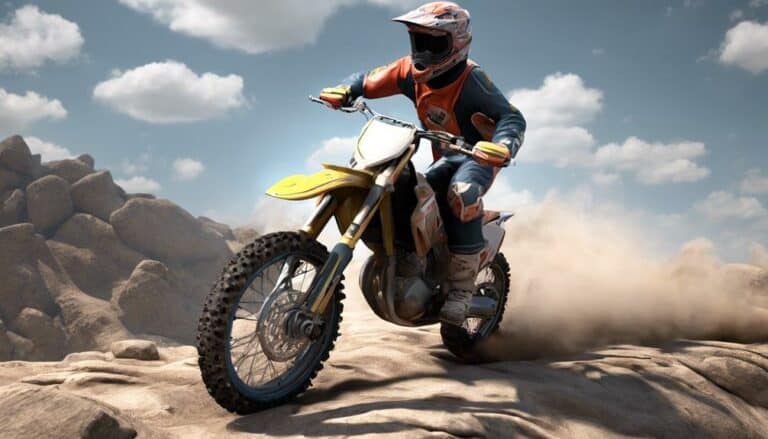When faced with rough terrains while dirt bike riding, you might worry about the risks involved. However, mastering the art of traversing challenging landscapes can be achieved through proper techniques and preparation.
By understanding how to adjust your body positioning, handle throttle and clutch control, and select the right gear, you can confidently tackle rough terrains with safety in mind.
Stay tuned to discover essential tips that will help you traverse these terrains safely and improve your off-road riding skills.
Key Takeaways
- Proper safety gear like helmets and body armor is crucial for protection on rough terrains.
- Understanding terrain features helps in choosing the best path and adjusting riding technique.
- Techniques for balance, like standing on foot pegs, aid in navigating off-road challenges effectively.
- Uphill climbing and downhill descents require specific strategies like maintaining momentum and low center of gravity.
Importance of Proper Gear Selection
Selecting the appropriate gear is essential for ensuring your safety and protection while riding through rough terrains on a dirt bike. When gearing up for your ride, make sure to equip yourself with a full-face helmet, body armor, knee and elbow pads, riding boots, goggles, and gloves. These items provide necessary protection against unpredictable terrain and potential falls. Additionally, they enhance visibility, grip, and overall comfort during your off-road adventures.
Maintaining proper tire pressure is key to traveling rough terrains safely. Make sure your rear tire has sufficient pressure to maintain balance and traction while riding. When approaching obstacles or challenging terrain, shift your weight forward to keep the front end light, making it easier to maneuver your dirt bike. Proper body positioning is important for stability and control, especially when encountering uneven surfaces. By keeping your weight forward and centered, you can effectively travel through rough terrains while maintaining balance.
Understanding Terrain Features
As you navigate rough terrains on your dirt bike, understanding the various features of the terrain is essential for maintaining control and safety throughout your ride.
When tackling steep inclines, keep your weight slightly forward to prevent the rear wheel from spinning out. Conversely, when descending, shift your weight to the rear to improve traction and stability.
Identify obstacles like rocks, roots, and ruts early on to choose the best path. Adjust your riding technique based on the terrain's slope, camber, and traction levels.
Be cautious of loose gravel, sand, and mud patches, reducing speed and balancing your weight to avoid skidding. Assess water obstacles such as crossings and streams for depth and flow before proceeding.
Stay vigilant on off-camber sections, maintaining control by leaning your bike into the slope. By staying aware of these terrain features and adjusting your approach accordingly, you can confidently navigate rough terrains while keeping control and balance.
Techniques for Maintaining Balance
To maintain balance while dirt bike riding on rough terrains, stand on the foot pegs and engage your legs to grip the bike securely. By keeping a balanced body position and utilizing your arms and legs as shock absorbers, you can effectively navigate the challenges of off-road riding.
Remember to keep your weight centered over the bike to prevent tipping and maintain control over uneven surfaces. Practice weight shifting techniques to adjust your balance according to the terrain you're riding on.
Smooth throttle control is important for maintaining stability and preventing sudden jerks that could lead to loss of balance. Additionally, focus on your body position to make sure you have the necessary control and balance while riding through rough terrains.
Strategies for Uphill Climbs
For tackling uphill climbs on your dirt bike with confidence and efficiency, maintaining momentum and steady throttle control is essential to prevent stalling. As you approach the incline, make sure you're in the correct gear ratio to provide enough power without overwhelming the engine.
Proper body positioning is pivotal; lean forward to keep your weight over the front wheel, increasing traction and preventing the front end from lifting. Scan the terrain ahead to identify traction spots such as rocks or hard surfaces that can help you maintain forward momentum.
When conquering steep uphill sections, utilize your momentum wisely. Controlled acceleration is key to managing the climb effectively. Avoid sudden bursts of speed that could lead to loss of traction or instability. Instead, modulate the throttle smoothly to keep the wheels gripping the terrain.
Safety Measures for Downhill Descents
Maintain a low center of gravity and stand on the foot pegs for improved balance and control while traversing downhill descents on your dirt bike. When tackling downhill slopes, it's important to implement proper safety measures to make a smooth and secure ride. Here are four essential tips to help you navigate downhill descents safely:
- Proper Body Positioning: Lean back slightly to prevent the front wheel from lifting off the ground on steep descents.
- Braking Techniques: Use both brakes evenly to control speed and prevent skidding. Practice controlled braking techniques and feather the brakes to modulate speed effectively.
- Terrain Awareness: Scan the terrain ahead to anticipate obstacles, choose the smoothest line, and adjust your speed accordingly for a safer descent.
- Tire Management: Make sure your front and rear tires have adequate traction by maintaining the right tire pressure and inspecting them regularly for wear and tear.
Conclusion
To navigate rough terrains safely while dirt bike riding, remember to always wear proper safety gear and master key techniques like body positioning and throttle control.
Did you know that over 80% of dirt bike accidents occur due to improper gear and lack of skill mastery?
By following these guidelines and practicing safe riding habits, you can enjoy the thrill of off-road riding while minimizing risks and staying safe on unpredictable terrains.

